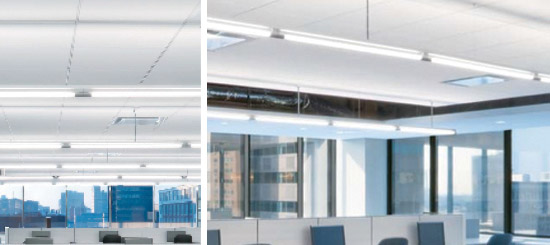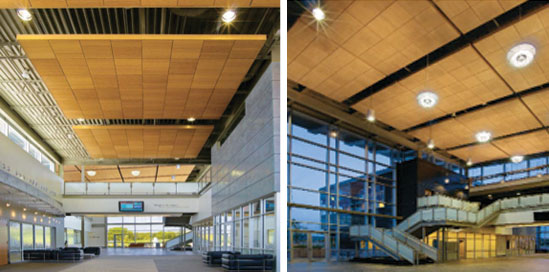A New World of Acoustics
Current and emerging options offer architects and designers a broad range of choice
![]() Continuing Education
Continuing Education
Use the following learning objectives to focus your study while reading this month’s Continuing Education article.
Learning Objectives - After reading this article, you will be able to:
- Analyze and explore the fundamental principles related to interior acoustic design, and their relationship to green buildings and sustainable design.
- Examine the traditional and new ceiling system options available to provide interior acoustic treatments that are both visually appealing as well as acoustically appropriate to the space use.
- Assess the various characteristics of acoustical ceilings that can contribute to green and sustainable building design.
- Recognize and identify the acoustic needs of different design applications and the attributes to look for, including contributions to green building certification.
As architects and designers, we are all aware that people experience a building with our human senses. While designs often pay the most attention to what we see, our sense of hearing is also directly impacted as soon as someone or something makes a sound in a building. If the quality of sound is not a factor considered in a design, then it can result in poor acoustic quality, distracting noise, or an irritating experience. Poor architectural acoustics can be annoying or distracting such that it can impede concentration, comprehension, healing, or learning. By contrast, good sound qualities can add drama, vibrancy, and energy, creating a useful, inspiring, and helpful experience.
Overall, when visually appealing spaces and acoustically appropriate techniques come together, the end result is a fully successful building design. To achieve this positive balance of visual and acoustical performance, architects and designers have more material and system options than ever to choose from. This is particularly true when it comes to ceilings which have long been used for acoustic control in buildings of all types. Understanding the full range of options currently available from manufacturers allows design professionals to create ceilings that perform well acoustically, add to the visual aesthetics, and contribute to sustainable designs.
Some Fundamentals of Acoustics
Acoustics is the scientific study of sound in all its forms, and architectural acoustics is specifically related to the interactions of sound both within and between architectural spaces. Professionals, specialists, and scientists have studied sound in terms of its generation, its transmission through space and objects, and its reception by people. In all cases, sound radiates outwards from the source, of which there are many, both inside and outside of buildings.

Photo courtesy of Armstrong Ceiling and Wall Systems
Architects and designers can control the visual appearance of ceilings and achieve excellent acoustic performance by understanding the many options available.
Sound is typically characterized by its loudness and frequency content, such that loudness is measured in decibels (dB) and frequency is measured in Hertz (Hz). The sound as heard within a space will be a combination of direct sound from the sources and sound reflected off the various surfaces within the space. Highly reflective surfaces will redirect sound without significant changes except for direction, which in very “hard” rooms can result in long delay times for arrival at the listener, causing echoes. Highly sound-absorptive surfaces on the other hand will diminish the reflected sound waves and reduce reverberation and echoes. Based on the sound behavior, people can experience different levels of speech intelligibility, speech privacy, or sound intrusion depending on the room size and shape and the acoustic treatments within or between spaces.
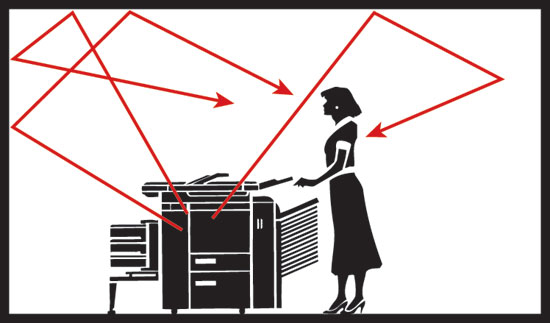
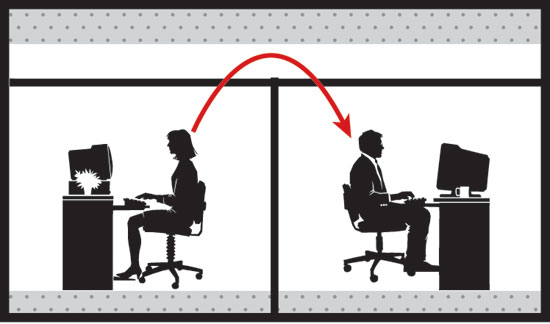

Images courtesy of Armstrong Ceiling and Wall Systems
Sound radiates out in all directions, but materials within a space will influence its effect on people. Materials with a high NRC (top image) dampen sound, those with a high CAC (middle image) reduce sound transfer through ceilings, and Sabin measurements (bottom image) determine effects of freestanding baffles.
Finding the right combination of sound absorption/reflection and sound attenuation (blocking) for a given space is a matter of using several well-developed tools to balance the acoustic characteristics within that space. (See sidebar in the online version of this course.) Sound absorption is the ability of a material or surface to deaden sound and is always frequency dependent. The sound absorption coefficient is measured on a scale of 0.0 – 1.0 over a frequency range, and the single number rating for a material is called the Noise Reduction Coefficient (NRC). The higher the NRC rating, the higher the overall (averaged over frequency) sound absorption of the material being measured. The NRC values published in ceiling manufacturers' data represent the percent of sound absorption per square foot of material used in continuous ceilings. If discontinuous ceilings are being installed or only partial areas have acoustic treatment (considered “unit” absorbers), then the overall sound absorption of the entire space can be measured and published as Sabins of absorption. Since we need to know the total sound absorption (Sabin) within a space, we can multiply the NRC by the number of square feet of continuous ceiling or we can add up the unit Sabins for the number and type of partial acoustical treatments that are in place.

Photo courtesy of Armstrong Ceiling and Wall Systems
Clouds and canopies are three-dimensional ceilings that are available in a variety of materials and acoustical properties.
The opposite of sound absorption is sound reflection which is also measured in the same way. A material with an NRC of 0.0 will reflect back all of the sound striking it and not absorb any. Typically, materials with NRC < 0.5 are considered sound reflectors. The use of too many sound-reflective materials, especially in large spaces, can create echoes and excessive reverberation of sound, which may be desirable in some cases, but not in others. A measure of reverberance is the Reverberation Time (RT) which is indicative of the persistence of sound after it was made, and is measured as the time it takes for sound to decay by 60 dB in level. Controlling or minimizing RT is particularly important in situations where people are listening to someone speaking since it directly affects the ability to understand the spoken word, which is referred to as “speech intelligibility.” Long reverberation times mean that the listener will be subjected to reflected sound with long delay times relative to the direct sound from the talker, and these late reflections will result in “overlaps” of spoken words, making it more difficult to understand.
Some of the sound generated within a space will not be entirely contained within the space, but can be transferred through walls and ceilings into adjacent spaces. This sound intrusion into other spaces can create a lack of privacy or the presence of unwanted noise. The most common method for measuring how much sound is being transferred between wall assemblies is the Sound Transmission Class or STC rating. A higher STC rating means that more airborne sound is blocked by the component or assembly. Lower STC ratings mean that more sound passes through the components or assemblies, adding to the background noise level in the space, degrading the ability to hear and understand speech.
It should be noted that, contrary to the popular notion that sound passes through a structure, such is not exactly the case. Sound generated on one side of a wall will energize the wall structure and set it in motion, much like a diaphragm. The wall itself becomes the transmitter of the sound energy which can be heard on the opposite side of the wall by the listener. Hence, the ASTM test methods used to determine STC ratings have focused on this direct transmission process, and the STC number is derived from sound attenuation values tested at 16 standard frequencies from 125 Hz to 4,000 Hz. The subjective perceptions of the STC ratings are generally accurate for speech sounds but less so for amplified music, mechanical equipment noise, transportation noise, or any sound with substantial low-frequency energy below 125 Hz.
When assessing the sound transfer through ceilings, the specific measurement is the Ceiling Attenuation Class (CAC). This rating is essentially the equivalent of an STC rating for walls, but is specific to the ceiling conditions where a dividing wall is constructed only to the ceiling height, allowing sound to pass through a plenum space above the ceiling. This is a “two pass” test in that the sound can transmit up through the ceiling in one space, across the ceiling plenum, and back down through the ceiling in an adjacent space. The higher the CAC rating, the more sound that is attenuated, meaning that less is transferred between spaces. In cases where the walls of a space do not extend all the way to the ceiling, such as with movable office partitions or partial height furniture, the appropriate measure is the Articulation Class (AC) rating. In this condition, it is speech privacy that is being rated so more absorption is being sought. Just like the CAC, a higher rating means that more sound is attenuated and less is transferred between office cubicles or similar spaces.
Acoustic Ceiling Options—Traditional and New
Using the principles of acoustics and the measurement processes available, ceiling manufacturers have been able to advance and refine their product offerings to provide architects and designers with a variety of choices. This variety allows for designs to be optimized for acoustic performance while still addressing visual and other aspects of the spaces.
Acoustical Ceiling Panels
Lay-in acoustical ceiling panels with a suspended grid system have been a traditional choice for many commercial and institutional buildings. They have commonly been available in standard 24-inch square or 24- x 48-inch rectangular sizes and made from mineral fiber or fiberglass materials. While these continue to be available and are a rather standard option, a whole new palette of ceiling panels and grids are also being produced. Ceiling panels are currently available in a wide range of sizes, patterns, and acoustical properties to suit a variety of design conditions. Long, narrow sizes such as 48 or 60 inches long by 6 inches wide are available as well as large 30-inch square panels among others. It is even possible to specify panels in trapezoidal shapes for situations where the ceiling radiates out visually from a rounded central area.
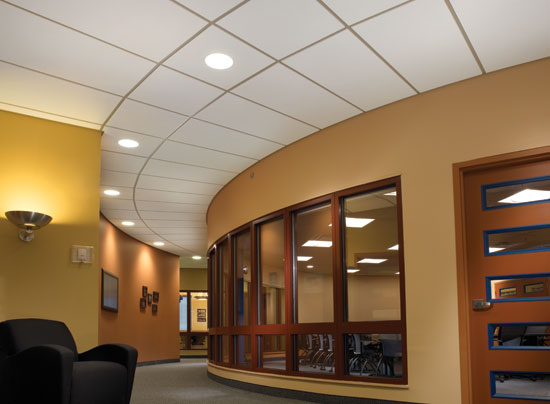
Photo courtesy of Armstrong Ceiling and Wall Systems
Traditional acoustic ceiling panels are available in more shapes and sizes, including shapes appropriate for ceilings radiating out from a circular center.
The choice of materials used for lay-in ceiling panels has also been significantly increased. In addition to mineral fiber or fiberglass, panels are also available in wood, metal, plastic, and translucent material with a variety of smoothness or textures. While the variety of materials contributes to the visual appearance and overall “feel” of a space, manufacturers have also included very good acoustic qualities into these ceiling panels. In some cases, that is achieved by using a pattern of very small (even ultra-small) perforations that are not visible when viewing the ceiling from below. Absorbent material is then added behind the panel that deadens the sound that passes through the perforations. The size and spacing of the perforations plus the reflectance of the panel material all combine to create desired NRC and CAC ratings.
Clouds and Canopies
A free-form approach to ceiling design has prompted the use of isolated panel formations that visually float below the structure above, hence promulgating the term “clouds.” While commonly available in square or round formations, the actual size, shape, and material are all variable. In this way, they can be designed to add a degree of acoustic control as well as visual appeal to a space. Similarly, a canopy can be added that is curved such that it adds a true three-dimensional aspect to a space and contributes to the acoustical performance at the same time. These canopies are commonly available from manufacturers in a variety of materials as well as a variety of acoustical properties.
Vertical Acoustical Treatments
In design situations where the horizontal plane of the ceiling is not desired but acoustic control is, then an alternate ceiling design can be created using vertically hanging acoustical treatments. In some cases, these treatments are long, linear acoustical elements that can be hung in unique configurations to aesthetically define spaces. They are generally available in rectangular standard sizes along with both standard and custom colors. These long, linear treatments can be suspended from a traditional 15/16-inch ceiling suspension system, or hung individually from the structure above. Properly designed and installed, they are approved for use in seismic areas and come with many options to achieve exceptional acoustical performance by reducing reverberation time in spaces.
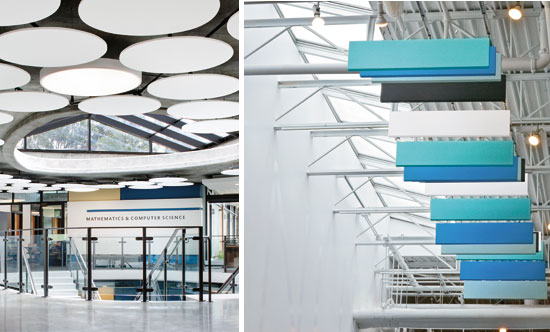
Photos courtesy of Armstrong Ceiling and Wall Systems
Left: Sound reverberation can be controlled with ceiling systems that are both acoustically efficient and visually exciting.
Right: Vertical acoustical treatments such as baffles used in this ceiling space help to control reverberation time and overall sound quality.
The term “acoustical baffles” applies to vertical hanging acoustical treatments that are commonly larger and shaped closer to squares than rectangles. Baffles are a very good acoustical solution in large spaces open to the roof structure. Tests have shown that it is possible to achieve a 50 percent average reduction in reverberation time with only about 25 percent coverage of baffles in the space. This type of treatment comes in a wide variety of material choices, colors, textures, edge details, and even shapes. They can include up to 100 percent post-consumer woven fabric content or even be made from rapidly renewable bio products. Baffles are also readily seismic approved and easy to install with adjustable aircraft cables. Overall they add acoustical control to spaces with an exposed structure or roof deck and readily add visual benefits of color and texture to the space.
Ceiling to Wall Systems
Using the same or similar material on a wall as the one used on a ceiling can make a strong visual statement when it comes to enclosing a space. It can also create a strong acoustic control, depending on the NRC rating of the material used. Seamless, integrated, and flowing transitions between ceilings and walls can be achieved using standard manufactured components. From crisp, 90° angles to active, inviting curves that ebb and flow with a particular design, a wide variety of three-dimensional enclosures can be achieved. The material choices are varied as well, including wood with a warm inviting look, metal with a cooler more sophisticated appearance, translucent materials that can add intrigue, or textured fabrics that can do many different things. Together, the combination of material and shape can be very dramatic or simple and understated.
From an acoustical standpoint, the materials used can have a very low NRC rating to create a sound reflective environment that may be required in a nightclub or other active environment. By contrast a high NRC rated material could be chosen to absorb sound and create a quieter space.
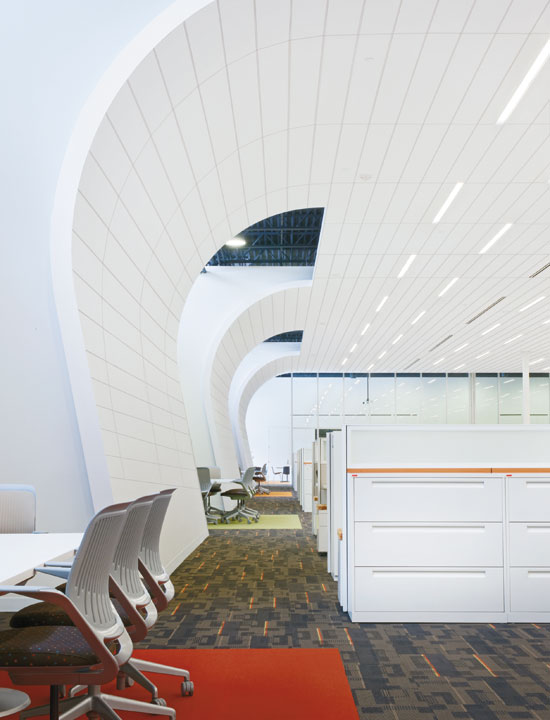
Photo courtesy of Armstrong Ceiling and Wall Systems
Extending the ceiling to become part of a wall system creates a visual and acoustical enclosure.
Green Building Contributions of Acoustic Ceilings
Ceilings are a big part of any building interior so it only makes sense that their sustainability should be addressed. The U.S. Green Building Council's (USGBC) LEED® rating system contains a number of areas where ceilings can contribute to a higher rating and more sustainability overall. This is true in both current versions of LEED that are in use, namely, LEED 2009 and LEED version 4.
Energy and Atmosphere
When designing an energy-efficient building, there is a tendency to focus on things like insulation and windows, but ceiling systems can also play a role in effective energy conservation. By using a ceiling system that has higher levels of light reflectance, less artificial light may be needed. Typical acoustical ceilings have a Light Reflectance (LR) rating of 0.75 meaning that they reflect 75 percent of the light striking is surface. High LR ceilings are made to reflect up to 90 percent of the light striking their surface. This means that the light coming from either natural daylighting systems or electrical lighting systems can be dispersed and spread farther with a high LR ceiling, thus making the space appear brighter with less light needed. This improves space illumination allowing for fewer light fixtures, a reduced electrical light output, lower maintenance costs, and reduced cooling load.
An innovative and emerging trend in energy efficiency related to ceilings is the use of lower voltage direct current (DC) power distributed through the ceiling suspension system to power electric lights. This concept is being actively promoted by the EMerge Alliance®, an open, not-for-profit industry association leading the rapid adoption of safe DC power distribution in commercial buildings through the development of standards. In particular, the EMerge Alliance standard for commercial interiors integrates interior infrastructures (like ceilings), power, controls and peripheral devices, such as lighting, in a common platform. This is all particularly significant on buildings where on-site solar or wind energy is being generated since the electricity produced in such systems is in DC form. Typically, it would then be converted to alternating current (AC) for use in buildings. However, a DC based grid system can eliminate energy lost from conversion and help accelerate use of DC-based LED lighting that is easy to locate, connect, and operate.
In LEEDv4, there is now a credit in the Interior Design and Construction (ID&C) system for Design Flexibility which recognizes and rewards different strategies that increase the useful life of the project space. Interior ceiling systems that are movable or demountable can directly contribute to this credit along with accessible ceiling systems. The DC powered ceiling system can also contribute to this credit since it offers the ability to safely alter and reuse interior spaces since the lighting can be repurposed and reconfigured without the need for rewiring.
Materials and Resources
Under LEED 2009, MR credit 4, Recycled Content, allows points for recycled material content in a new or renovated building. Mineral fiber, fiberglass, and wood ceiling products have a recycled content from 47 percent to 92 percent depending on the material specified. Additionally, high recycled content suspension systems and grids made from metals are also available. There are also a growing number of ceiling products that are being made from bio-based rapidly renewable materials meaning they may qualify under MR credit 6 for one point. Similarly, if wood ceilings are specified, they may also qualify for an additional point if certified wood is used under MR credit 7. And of course, when any of these ceiling products are manufactured in the USA that means regional material contribution may be possible under MR credit 5. If LEEDv4 is being used, there is a new section of credits on Building Disclosure and Optimization. This new area rewards products that have Environmental Product Declarations (EPDs) disclosing the manufacturers life cycle inventory of a product. The formerly single attributes such as recycled content, FSC certification, recyclable content, etc. are now all part of this life cycle assessment / EPD process. Currently, EPDs are available for some, but not yet all, ceiling system products.
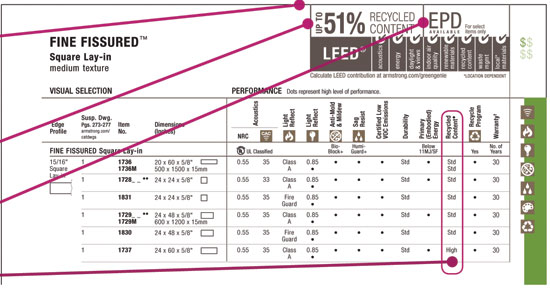
Image courtesy of Armstrong Ceiling and Wall Systems
Ceiling manufacturers can provide information about the sustainability of their products to show LEED point contributions and Environmental Product Declaration (EPD) information.
In cases where an existing building is being remodeled, MR credit 3, Materials Reuse, allows either 1 or 2 points based on thresholds of 5 percent or 10 percent of material being re-used. Many of the ceiling systems discussed already are long lasting and durable or have built-in flexibility meaning that they should be considered for ongoing use as part of a renovation project. However where that is not practical or consistent with other design parameters, then look for a manufacturer that will take back the existing ceilings for recycling and re-use. That will not only be the most appropriate thing for the total life cycle of the ceilings, it can also contribute to 1 or 2 points under MR credit 2, Construction Waste Management by diverting this material from a landfill.
Indoor Environmental Quality
There are a number of ways that ceilings can contribute to improved indoor environmental quality (EQ). We have mentioned the higher light reflectivity option that can aid in extending daylighting into the space. Recent independent studies have shown a 10-15 percent increase in the effectiveness of daylighting designs with the use of these ceilings. That means that indirect lighting is spread further providing higher visual comfort and improving the effectiveness of people working. Beyond this EQ trait, most ceiling products are pre-finished and qualify as low emitting materials due to low or no VOC content in the ceiling panels. Further, no paints, coatings, adhesives, or harmful sealants are typically needed for ceilings so those concerns are eliminated.
One of the growing concerns in green building design is the role that acoustics can play in terms of indoor environmental quality. In particular, LEED for Schools contains both a pre-requisite and a credit possibility for improved classroom acoustics using ANSI Standard S12.60 as the basis for performance. This standard and the IEQ inclusion comes from studies that have demonstrated that excessive reverberation and noise in a classroom interferes with a student's ability to clearly hear their teacher which obviously affects a student's ability to learn. The standard addresses Direct Sound which in this case is the sound of a teacher's voice traveling directly from the teacher to the student. This is always beneficial in terms of speech intelligibility because direct sound is not affected by anything in the room, making it clear and distinct. The standard also addresses Reflected Sound and Reverberation Time as they are specifically related to speech intelligibility. Finally it addresses, Background Noise defined as any sound that is generated outside the building, such as playground activity, traffic, planes, etc. that generally intrudes into the classroom by way of the windows or as noise from within the building such as HVAC system noise and corridor noise. Using ceiling systems that have appropriate NRC, CAC, and STC ratings plus proper RT measurements for different areas of school building will be necessary in order to meet the pre-requisite and the credit point in a LEED for Schools building.
While LEED for Schools is the only version of LEED v. 4 that has a minimum acoustic performance pre-requisite, other LEED rating systems now include a credit for acoustic performance based on acoustic design. These include 1 available point for LEED for New Construction, Data Centers, Hospitality, Warehouses and Distribution Centers, plus up to 2 points in LEED for Healthcare. Ceilings can obviously be used to contribute to the overall acoustic design and earning LEED points in this category.
Designing for Specific Building Types
The principles and characteristics of ceilings for acoustic and visual design are rather universal across all building types. However, the specific needs of different types of buildings will dictate the ways those principles are applied and the choices of final materials and systems. Some of the more common applications are discussed briefly in the following sections.
Workplaces
Good acoustic design in contemporary workplace environments address both quiet concentration and energetic collaboration. Studies have shown that noise at the office reduces worker effectiveness, raises stress, and lowers employee satisfaction. To address these issues, speech privacy and excessive reverberation time can be directly addressed using appropriate acoustical design solutions.
In open plan offices contributors of noise can include employee conversations, benching workstations, speaker phones, etc. To counteract this noise, a balanced acoustical design requires high AC and high NRC products that absorb sound and keep it from spreading very far from its source. Closed plan offices will help contain sound within each office, but there is still the concern of sound transfer from room to room if walls are built to ceiling height only. In this case, high CAC products are a must to prevent sound transfer through the ceilings of adjacent offices. Higher STC ratings are needed in the walls for the same sound containment reason.
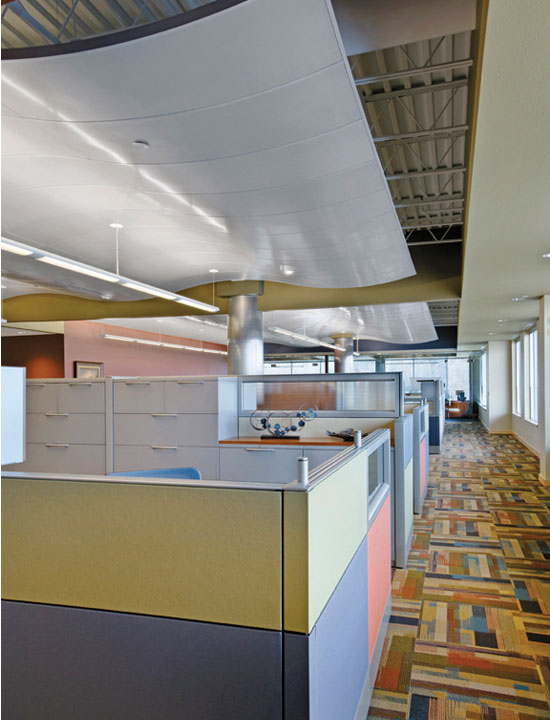
Photo courtesy of Armstrong Ceiling and Wall Systems
Different office spaces can be treated with different ceiling treatments to control acoustical performance.
Aside from individual workspaces, office buildings may contain other types of spaces as well such as group collaboration areas where teaming activities require open communications within groups. However, there is also a need for some moderate separation between different groups or between these collaboration areas and private offices. That means that high NRC or AC ceilings and perhaps clouds/canopies or baffles are needed to complement low/high furniture systems. By contrast, there may also be a need for quiet or private areas within a workplace setting. In these areas it will be important to minimize the transfer of sound in all directions, hence, high CAC and AC rated ceilings, high STC wall ratings, (high furniture panels in open plan settings), and even the possibility of electronic sound masking (background music or white noise) are all design elements to consider incorporating. Of course, there are always some specialty areas that may require some unique consideration such as retail, lobby, or support spaces that need some other types of treatment such as high NRC ratings all around for higher absorption or moderate NRC ratings to allow for some desired reverberation. In short, by looking at the different acoustic needs of each of the spaces within a workplace building, they can each be designed independently from an acoustic perspective to produce successful results.
Education
Good acoustical design in schools address high performing learning environments for students and for teachers. Excessive reverberation and noise in a classroom interferes with a student's ability to clearly hear their teacher. In fact, studies indicate that students typically hear only 3 out of every 4 words in the classroom. Good acoustical design promoting high speech intelligibility is key to understanding and learning from all of the words.
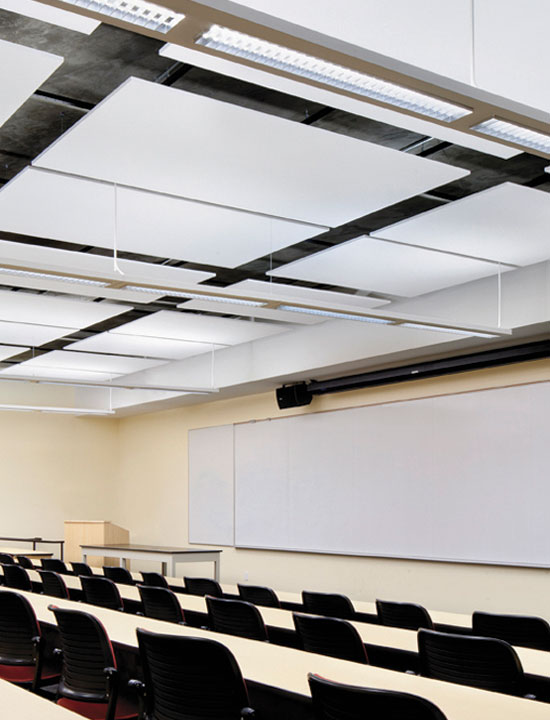
Photo courtesy of Armstrong Ceiling and Wall Systems
Acoustically designed classrooms following ANSI Standard S12.60 creates spaces that promote better learning and speech intelligibility.
As in workplace situations, acoustical considerations for schools vary by space although all will benefit by being acoustically separated from each other. Classrooms and libraries will generally need to be quieter with higher NRC, CAC, and STC ratings than larger open spaces such as cafeterias, gymnasiums, or auditoriums which may accept more reverberation. As mentioned earlier, ANSI Standard S12.60 is used as a performance standard in the LEED for schools rating system, but it is a useful standard even if the building is not seeking LEED certification. Among the things that this standard establishes is the need to first design the architecture for good speech clarity using acoustically appropriate materials and systems within the space. Then, in order to protect that clarity and high speech intelligibility, it sets standards for low background noise from neighboring spaces and outdoor sources that can also be addressed by acoustical design principles. Altogether, students and teachers who function in an acoustically designed school will be more effective and happier without the distractions of unwanted sound.
Healthcare
Healthcare facilities are increasingly requiring good acoustic design as a functional requirement for speech privacy under the federally mandated HIPAA privacy rule. That means that anywhere patient information is being discussed and there are other people in the vicinity, speech sound must be controlled or absorbed. Hence administrative areas where multiple patients are seen will require areas to meet and talk that have high NRC, CAC, AC, and STC ratings to prevent the unwanted and unlawful dissemination of a patient's private information.

Photo courtesy of Armstrong Ceiling and Wall Systems
Acoustically isolated spaces in healthcare facilities help control sound transfer and protect privacy.
Beyond this basic sound control need, there is evidence to indicate that optimum patient recuperation occurs when acoustics are taken into account in the design. Excessive noise is created by the 24/7 environment of corridor activity, busy nurse's stations, equipment, alarms, and activity in treatment rooms among other things. Studies indicate that on average, hospital noise levels from all of this activity exceed those set by the World Health Organization. The significance is that these elevated noise levels are attributed to increasing patient stress and having an adverse effect on patient comfort. The design of healthcare spaces can sometimes make this worse by using hard, sound reflective surfaces, by not building walls all the way to the deck above, or by failing to treat and isolate high noise areas. Hence designing to acoustically separate patient rooms from sources of noise and using sound absorptive materials in areas that are generating the sound can directly contribute to the success of the hospital operations. This will not only help patients, but the healthcare staff as well who can benefit from a more pleasant work environment while reducing the possibility of missed communication due to better speech intelligibility.
Conclusion
Acoustics has become a rather well understood aspect of building design in terms of defining desirable sound conditions and how to measure and address concerns. Manufacturers of acoustical building products have used this information to understand that one design does not fit all conditions, but rather they offer a full range of visually and acoustically appropriate products to suit a wide range of design needs. Therefore, it is now easier and more needed than ever to take time during the design process to consider acoustical needs in all buildings. The multiple options available readily puts the architect in control of the level of acoustic performance in ceilings and entire spaces. At the same time, the visual appearance of these ceilings and spaces can be used to integrate with and enhance virtually any design.
 |
Armstrong is a leader in the design and manufacture of commercial ceilings with the broadest portfolio of standard and custom options available including mineral fiber/fiberglass, wood, metal, and translucent materials. Armstrong offers innovative interior solutions that help to enhance comfort, save time, improve building efficiency and overall performance, and create beautiful spaces, from Dubai to Shanghai, New York to Sao Paolo. |

